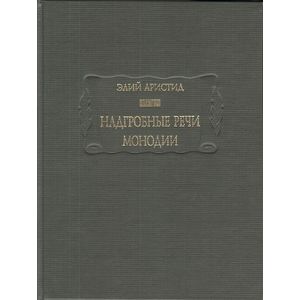Tombstones. Monodia
Please sign in so that we can notify you about a reply
In this volume of the series "Literary Monuments", a complete collection of works of an interesting genre of ancient literature - ancient Greek tombstones preserved from the period from the V century. BC e. In the 4th century n. e. Part of them belongs to the classical era of ancient Greece (V-IV centuries BC), the other belongs to the time of the Roman Empire. Under one binding, both official speeches are combined, made in the presence of a large number of citizens, characterized by honed style and solemnity, and initiation to private individuals, often to friends and relatives of the speaker, and therefore more soulful, noted by the power of personal feelings. The latter include several speeches of the famous speaker of the II century. n. e., the largest representative of the second sophistry Eliya Aristide, forming the basis of this publication.
Making an important part of the ancient funeral rite, the tombstones (monodia and epitaphs) served the goals of ritual mourning of the deceased and perpetuated the memory of the dead among relatives, fellow citizens and descendants. The addressees of such speeches became as people of all kinds of classes and titles (a mocking young speaker, a great ruler who fell on the battlefield, an athlete who had gone for the time being and not defeated by anyone, a glorious commander and his nameless soldiers - zealots and defenders of the Fatherland) and destroyed), and destroyed Flame temples, destroyed palaces, columns and statues, finally, entire cities, to the ground destroyed by people or swept away by the expression of divine will ".
These speeches are not only distinguished by the wealth of language and imagery, an abundance of mythological allusions and reminiscences, but also offer a wide historical excursion, reflecting the events of military and peacetime, describing solemn rites, entertainment and life. So, for example, one of the texts describes in detail the history of the Eleusian mysteries - the most important religious festival, uniting in antiquity tens of thousands of people and gave, as it was believed, the hope of salvation of the soul and eternal life after death.
The “Additions” section included selected excerpts from ancient oratory textbooks, telling in detail how epitaphs and monodia were happening, and revealing the "Creative Laboratory ”of the ancient rhetoric for the reader.
Most speeches are translated into Russian for the first time.
The publication is equipped with a thorough article by S.I. Mezheritskaya, reflecting the history and development of ancient tombstone eloquence, vast historical and philological commentary, two announced signs, allowing to better navigate in volume, as well as an illustration album that reflects both ancient culture and its later European reception.
It is recommended to a wide circle of readers
Making an important part of the ancient funeral rite, the tombstones (monodia and epitaphs) served the goals of ritual mourning of the deceased and perpetuated the memory of the dead among relatives, fellow citizens and descendants. The addressees of such speeches became as people of all kinds of classes and titles (a mocking young speaker, a great ruler who fell on the battlefield, an athlete who had gone for the time being and not defeated by anyone, a glorious commander and his nameless soldiers - zealots and defenders of the Fatherland) and destroyed), and destroyed Flame temples, destroyed palaces, columns and statues, finally, entire cities, to the ground destroyed by people or swept away by the expression of divine will ".
These speeches are not only distinguished by the wealth of language and imagery, an abundance of mythological allusions and reminiscences, but also offer a wide historical excursion, reflecting the events of military and peacetime, describing solemn rites, entertainment and life. So, for example, one of the texts describes in detail the history of the Eleusian mysteries - the most important religious festival, uniting in antiquity tens of thousands of people and gave, as it was believed, the hope of salvation of the soul and eternal life after death.
The “Additions” section included selected excerpts from ancient oratory textbooks, telling in detail how epitaphs and monodia were happening, and revealing the "Creative Laboratory ”of the ancient rhetoric for the reader.
Most speeches are translated into Russian for the first time.
The publication is equipped with a thorough article by S.I. Mezheritskaya, reflecting the history and development of ancient tombstone eloquence, vast historical and philological commentary, two announced signs, allowing to better navigate in volume, as well as an illustration album that reflects both ancient culture and its later European reception.
It is recommended to a wide circle of readers
Cover:
Cover:Hard
Category:
- Category:Arts & Photography
- Category:Education & Teaching
- Category:Religion & Spiritually
- Category:Social Science & Politics
Publication language:
Publication Language:Russian
Series:
Series: Literary Monuments
ISBN:
ISBN:978-5-86218-550-8
No reviews found
